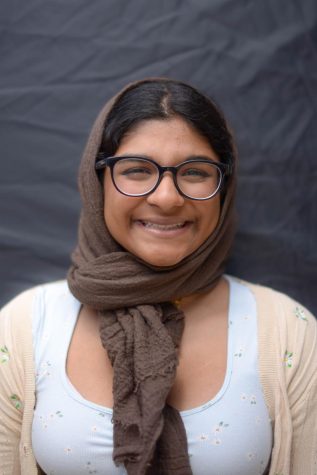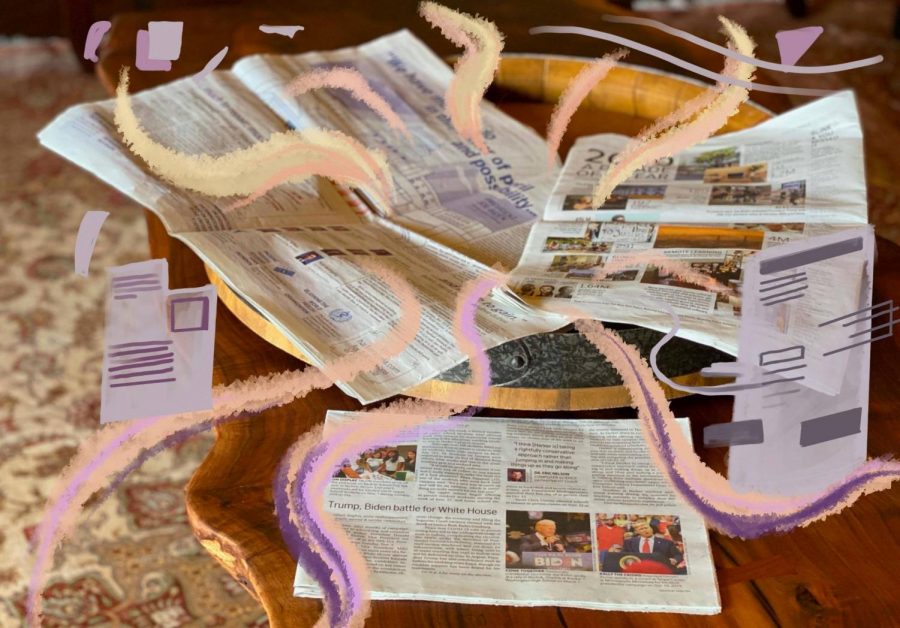Open hands and truth
Journalism as a communal soil, as a ground for sharing
As Student Press Freedom Week is taking place during Feb. 21 to Feb. 27, I have been thinking about the work our journalism staff has been doing. We have been holding the theme for this year in our hands: “journalism against the odds.” We have pushed past the boundaries to do what we have always done: served the community, provided an avenue towards truth, giving voice to the voiceless.
I joined the journalism staff as a freshman — new to high school and unfamiliar with what student journalism meant. I loved to write and choosing to take journalism felt simple: I was excited by the possibility of being able to see my work physically on paper.
I remember slipping into the room on the first day of school and being greeted by underclassmen and upperclassmen alike, by soft sofas and bright blankets, copies of newspapers tacked onto the wall. This was my first impression of the journalism room: a warm space — small and tender and safe. I soon learned it to be so much more: the work we did was important.
That November, after I had been on staff for a few months, I was shivering in the gymnasium while the administration told us about threatening graffiti that had been found in the bathroom. In journalism class the next day, we separated truth from rumor, we made sense of the moment, and we talked about our feelings regarding the situation.
We published news pieces and editorials about what happened, even interviewing a security guard and a freshman. As more and more rumors floated around campus, our publications served as an anchor for the community: a chance for the school to see what was true, to understand the information that had been verified.
In a time of hardship and uncertainty, we as journalists provided awareness for what had taken place and delivered work that was, above all, true. Each message had been fact-checked again and again, each quote spoken and later transcribed.
I began to learn that journalism was a space and a tether for the community to rely on. Through the fear, through the helplessness, journalism gave stories that held what we needed most — hope, unadorned and gentle. The pieces we published were not cloaked in superfluous language or elements of fantasy. Instead, we mined facts and opinions from the community brought them to light, as if jostling someone’s shoulder and saying, Here, here is what we really know.
Beyond our class discussions, as journalists we shared what we knew and felt with the world around us: the upper school community. I watched as the staff moved collectively, as one body rather than many, black camera bags slung over shoulders, small cream reporter’s notebooks and blue pens in every curled hand.
I watched as, during the next school meeting, two girls sitting in front of me pulled up Harker Aquila on their phones, scrolling through the article that had been published overnight by the journalism staff with information about the incident from faculty and students.
From that moment, I began to understand student journalism as a duty and responsibility, pouring what information we can glean into the community’s hands and looking upon findings together. It wasn’t always easy — during class I heard about the staff’s sleepless nights, their deep conversations — but it was worth it to be able to speak and to share and to create this healing in the face of heartbreak, this togetherness when our community needed it most.
In the whirlwind of anger and hurt, it is easy to feel lost in cycles of possibility: what could happen? It becomes more and more difficult to hold grounding, to understand which parts of the surrounding whispers are real and which parts are made up or exaggerated.
Student journalism is necessary, in this beautiful and tangible way, because it allows a community of people who are growing a place to begin, a place to trust. Through journalism, students can listen in on the voices of the community and contribute their own ideas and perspectives.
As Student Press Freedom Week is taking place during Feb. 21 to Feb. 27, I have been thinking about the work our journalism staff has been doing. We have been holding the theme for this year in our hands: “journalism against the odds.” We have pushed past the boundaries to do what we have always done: served the community, provided an avenue towards truth, giving voice to the voiceless.
As student journalists, we have faced so many challenges over the past year and have had to carry ourselves as journalists into situations suffused with anger and fear: the pandemic, the election, the Black Lives Matter protests.
During the pandemic, we’ve had to organize newspaper issues to be sent to homes during the pandemic and think deeply about ways in which we could coordinate pictures to add alongside articles. We’ve worked and brainstormed over Zoom instead of the cozy journalism room.
The work we do has been fraught with complications. But even when things were difficult, the staff persevered, pushing through what we have been given into what we need to do for our community. We understand our duty as journalists: to service the community, and we strove to follow through with it.

Sarah Mohammed (12) is the co-editor-in-chief of the Winged Post, and this is her fourth year on staff. This year, she is excited to help make beautiful...


















![“[Building nerf blasters] became this outlet of creativity for me that hasn't been matched by anything else. The process [of] making a build complete to your desire is such a painstakingly difficult process, but I've had to learn from [the skills needed from] soldering to proper painting. There's so many different options for everything, if you think about it, it exists. The best part is [that] if it doesn't exist, you can build it yourself," Ishaan Parate said.](https://harkeraquila.com/wp-content/uploads/2022/08/DSC_8149-900x604.jpg)




![“When I came into high school, I was ready to be a follower. But DECA was a game changer for me. It helped me overcome my fear of public speaking, and it's played such a major role in who I've become today. To be able to successfully lead a chapter of 150 students, an officer team and be one of the upperclassmen I once really admired is something I'm [really] proud of,” Anvitha Tummala ('21) said.](https://harkeraquila.com/wp-content/uploads/2021/07/Screen-Shot-2021-07-25-at-9.50.05-AM-900x594.png)







![“I think getting up in the morning and having a sense of purpose [is exciting]. I think without a certain amount of drive, life is kind of obsolete and mundane, and I think having that every single day is what makes each day unique and kind of makes life exciting,” Neymika Jain (12) said.](https://harkeraquila.com/wp-content/uploads/2017/06/Screen-Shot-2017-06-03-at-4.54.16-PM.png)








![“My slogan is ‘slow feet, don’t eat, and I’m hungry.’ You need to run fast to get where you are–you aren't going to get those championships if you aren't fast,” Angel Cervantes (12) said. “I want to do well in school on my tests and in track and win championships for my team. I live by that, [and] I can do that anywhere: in the classroom or on the field.”](https://harkeraquila.com/wp-content/uploads/2018/06/DSC5146-900x601.jpg)
![“[Volleyball has] taught me how to fall correctly, and another thing it taught is that you don’t have to be the best at something to be good at it. If you just hit the ball in a smart way, then it still scores points and you’re good at it. You could be a background player and still make a much bigger impact on the team than you would think,” Anya Gert (’20) said.](https://harkeraquila.com/wp-content/uploads/2020/06/AnnaGert_JinTuan_HoHPhotoEdited-600x900.jpeg)

![“I'm not nearly there yet, but [my confidence has] definitely been getting better since I was pretty shy and timid coming into Harker my freshman year. I know that there's a lot of people that are really confident in what they do, and I really admire them. Everyone's so driven and that has really pushed me to kind of try to find my own place in high school and be more confident,” Alyssa Huang (’20) said.](https://harkeraquila.com/wp-content/uploads/2020/06/AlyssaHuang_EmilyChen_HoHPhoto-900x749.jpeg)



